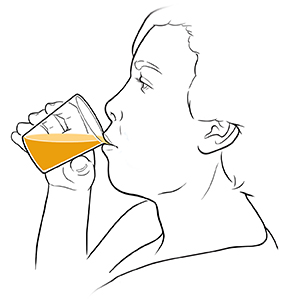Low blood sugar (hypoglycemia) means you don’t have enough sugar (glucose) in your bloodstream to help your body work. This may be a level of sugar lower than 70 mg/dL. But talk with your healthcare provider about your own target range. Ask what level is too low for you.
Diabetes doesn’t cause low blood sugar. But some treatments for diabetes may raise the risk for it. These include oral medicines or insulin. Skipping or delaying meals can also increase your risk for hypoglycemia. In severe cases, low blood sugar may make you pass out or have a seizure. This is a medical emergency. So always treat low blood sugar right away as noted below. This is to prevent more serious problems.
Safety note
Always carry a source of fast-acting sugar and a snack in case you have low blood sugar. Examples include:
-
4 glucose tablets
-
1 tube of glucose gel
-
1 packet of sugar or honey
-
2 tablespoons of raisins
Symptoms of low blood sugar
If you have low blood sugar, you may have 1 or more of these symptoms:
-
Shakiness
-
Dizziness
-
Cold, clammy skin or sweating
-
Hunger
-
Headache
-
Nervous feeling
-
A hard, fast heartbeat
-
Weakness
-
Confusion or irritability
-
Trouble seeing or talking
-
Having nightmares or waking up confused or sweating
-
Numbness or tingling in the lips or tongue
What to do
If you think you have low blood sugar:
-
Check your sugar. First, check your blood sugar. If it's too low (out of your target range), eat or drink 15 to 20 grams of fast-acting sugar. This may be 3 to 4 glucose tablets, or 4 ounces (half a cup) of fruit juice or regular (not diet) soda, or 1 tablespoon of honey. Don’t take more than this. If you do, your blood sugar may go too high.
-
Don’t have protein. Don't eat or drink things high in protein to treat low blood sugar. This includes milk, nuts, and meat. Protein may increase your insulin response. It may lower your blood sugar even more.
-
Check again. Wait 15 minutes. Then recheck your blood sugar if you can. If your blood sugar is still too low, repeat the steps above until your blood sugar is back to normal.
-
Eat a snack. When your blood sugar is back at target range, eat a snack or meal.
-
Get help if needed. If you still don’t feel well and your blood sugar is still low, have someone drive you to the emergency room.
Preventing low blood sugar
Things you can do include the below:
-
If your diabetes needs a strict treatment plan, eat meals and snacks at the same times each day. Don’t skip meals. If you have trouble paying for food, talk with your healthcare team for help.
-
If your treatment plan lets you change when and what you eat, learn how to change the time and dose of your rapid-acting insulin to match.
-
Ask your healthcare provider if it's safe to drink alcohol. But never drink on an empty stomach. Alcohol may keep you from feeling the first symptoms of low blood sugar.
-
Take your medicine at the prescribed times.
-
Always carry a source of fast-acting sugar and a snack when you’re away from home.
If you have had repeated low blood sugar episodes:
-
You may not notice the symptoms of low blood sugar until it gets to a dangerous level. Work with your provider for the best ways to safely manage your blood sugar.
-
Ask your healthcare provider if you can take less or different medicine. Many newer types of diabetes medicines have less risk of low blood sugar.
-
Talk with your provider about a continuous glucose monitor. This is a device that tracks your blood sugar.
-
Ask your provider if you should be prescribed a medicine called glucagon. Glucagon is a hormone that quickly raises blood sugar. It can reverse serious symptoms. It is available as an injection or as a powder that's put into the nose. Ask your healthcare provider which type of glucagon is best for you and how to use it.
Other safety tips
Make sure to:
-
Carry a medical ID card or wear a medical alert bracelet or necklace. It should say that you have diabetes. It should say what to do if you pass out or have a seizure.
-
Teach your family, friends, and coworkers the signs of low blood sugar. Tell them what to do if your blood sugar falls very low and you can’t treat yourself.
-
Keep a glucagon emergency kit handy. Show your family, friends, and coworkers how and when to use it. Check it often. Replace the glucagon before it expires.
-
Talk with your healthcare team about other things you can do to prevent low blood sugar. These include using new ways of continuous glucose tracking.
Important
If you have unexplained low blood sugar or have it several times, call your healthcare provider.


